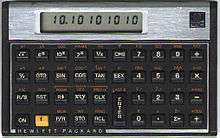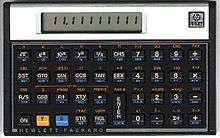Hewlett-Packard Voyager series
The Hewlett-Packard Voyager series of calculators were introduced by Hewlett-Packard in 1981.[4] All members of this series are programmable, use Reverse Polish Notation, and feature continuous memory. Nearly identical in appearance, each model provided different capabilities and was aimed at different user markets.
 HP-10C | |
| Type | Programmable Scientific |
|---|---|
| Manufacturer | Hewlett-Packard |
| Introduced | 1982 |
| Discontinued | 1984 |
| Cost | USD 80 |
| Calculator | |
| Entry mode | RPN |
| Display type | LCD seven-segment display |
| Display size | 10 digits |
| CPU | |
| Processor | HP Nut core (1LF5[1]) |
| Programming | |
| Programming language(s) | Keystroke programmable (fully merged) |
| Memory register | 0…9 registers (R0…R9) plus X, Y, Z, T, LAST X[2] |
| Program steps | 9…79 lines[2] |
| Other | |
| Power consumption | 0.25 mW |
 HP-11C | |
| Type | Programmable Scientific |
|---|---|
| Manufacturer | Hewlett-Packard |
| Introduced | 1981 |
| Discontinued | 1989 |
| Cost | USD 135 |
| Calculator | |
| Entry mode | RPN |
| Display type | LCD seven-segment display |
| Display size | 10 digits |
| CPU | |
| Processor | HP Nut core (1LF5 / 1LM2 / 1LQ9[1]) |
| Programming | |
| Programming language(s) | Keystroke programmable (fully merged) |
| Memory register | 0…20 registers (R0…R9, R.0…R.9) plus RI, X, Y, Z, T, LAST X[3] |
| Program steps | 63…203 lines[3] |
| Other | |
| Power consumption | 0.25 mW |
Models
The HP calculators Voyager series consisted of five models, some of which were manufactured in several variants (with years of production):
- HP-10C – basic scientific calculator (1982–1984).
- HP-11C – mid-range scientific calculator (1981–1989).
- HP-12C – business/financial calculator (1981–present).
- HP-15C – advanced scientific calculator (1982–1989, 2011).
- HP-16C – computer programmer's calculator (1982–1989).
HP-10C
The HP-10C is the last and lowest-featured calculator in this line, even though its number would suggest an earlier origin. The 10C was a basic scientific programmable. While a useful general purpose RPN calculator, the HP-11C offered twice as much for only a slight increase in price. Designed to be an introductory calculator, it was still costly compared to the competition, and many looking at an HP would just step up to the better HP-11C. Poor sales led to a very short market life, making it one of the most difficult of the series to find today.
HP-11C
The HP-11C is a mid-range scientific programmable calculator.
HP-12C
The HP-12C is a popular financial calculator. It was such a successful model that Hewlett-Packard redesigned it from scratch,[1] added several new functions, and introduced it as the HP 12c Platinum in 2003 as well as the HP 12c Prestige. Over the course of years, several anniversary editions of the calculator were produced as well.
The HP-12C is HP's longest and best-selling product, in continual production since its introduction in 1981.[4]
HP-15C
The HP-15C is a high-end scientific programmable with a root-solver and numerical integration, produced between 1982 and 1989. It is also able to handle complex numbers and matrix operations. Although long being discontinued its continued popularity among users triggered Hewlett-Packard to offer a HP 15c Limited Edition remake of the calculator in 2011.
HP-16C
The HP-16C is a computer programmer's calculator, designed to assist in debugging. It can display numbers in hexadecimal, decimal, octal and binary, and convert numbers from one base to another. A number of specialized functions are provided to assist the programmer, including left- and right-shifting, masking, and bitwise logical operations. HP has (as of 2015) never made another programmer's calculator, but has incorporated the 16C's functions in later calculator models.
Features
Arithmetic
Hewlett-Packard retained the numerical analyst William Kahan of UC Berkeley, the architect of the IEEE 754 standard for floating-point arithmetic, to design the numerical algorithms implemented by the calculators.[5][6] He also wrote parts of the manuals.
Programming
The HP Voyager series calculator are keystroke programmable, meaning that it can remember and later execute sequences of keystrokes to solve particular problems of interest to the user. These keystroke programs, in addition to performing any operation normally available on the keyboard, can also make use of conditional and unconditional branching and looping instructions, allowing programs to perform repetitive operations and make decisions.
The available programming features differentiate between the various HP Voyager series calculator systems.
| Function | HP-10C | HP-11C | HP-12C | HP-15C | HP-16C |
|---|---|---|---|---|---|
| BSP / ← [F 1] | No | Yes | No | Yes | Yes |
| LBL [F 2] | No | Yes | No | Yes | Yes |
| GSB/RTN [F 3] | No | Yes | No | Yes | Yes |
| x≤y, x=0 | Yes | Yes | Yes | Yes | Yes |
| x=y, x≠y | No | Yes | No | Yes [F 4] | Yes |
| x<0, x≠0, x>y, x>0 | No | Yes | No | Yes [F 4] | Yes |
| x>0, x≤0, x≥y, x≥0 | No | No | No | Yes [F 4] | No |
| DSE, ISG [F 5] | No | Yes | No | Yes | No |
| DSZ, ISZ [F 5] | No | No | No | No | Yes |
| SF, CF, F? | No | Yes | No | Yes | Yes |
| I (I) [F 6] | No | Yes | No | Yes | Yes |
- Without BSP (backspace) programs can only be edited by overwriting existing steps.
- Without LBL (Label) goto commands can reference only absolute program steps.
- Without GSB (Go Subroutine) / RTN (Return from Subroutine) one cannot write subroutines.
- Available via the g TEST n (indirect) function
- Without DSZ/DSE (Decrement and Skip) and ISZ/ISG (Increment and Skip) writing loops is difficult.
- Without indirect addressing only the first 20 (0…19) register can be accessed. Also the programming model is not turing complete.
Legacy
The HP-12C and its derivatives remains in widespread use today and is still available from Hewlett-Packard. The long-discontinued HP-15C was re-released in a "Limited Edition" in 2011 that has again been discontinued.
Emulators
Official emulators for the 12C and 15C are commercially available from Hewlett-Packard for Android[7] and iOS[8] devices.
Clones
In 2011, the continued popularity of the Voyager series among users prompted SwissMicros to produce a series of credit-card-sized calculators looking like miniature versions of their HP equivalents and running the original HP firmware in an emulator on a modern calculator hardware. The series consists of the DM10, DM11, DM12, DM15 and DM16.[9] All calculators use the same hardware, but differ in keyboard and firmware (which can be changed with an upgrade port). After the introduction of the larger DM15L, DM41L and DM16L in 2015, the DM11L was added in January 2016 with the DM12L following in February. A limited production run for a DM10L is planned for 2019.[10][11]
References
- Smith, Eric (2009-07-28). "HP Voyager Calculator Variants". Retrieved 2015-11-20.
- Hewlett-Packard HP-10C Owner's Handbook (PDF) (1 ed.). Corvallis, Oregon, USA: Hewlett-Packard Company, Corvallis Division. February 1982. HP part-number 00010-90025. Archived (PDF) from the original on 2015-10-05.
- Hewlett-Packard HP-11C Owner's Handbook and Problem-Solving Guide (PDF) (G ed.). Corvallis, Oregon, USA: Hewlett-Packard Company, Corvallis Division. November 1985. HP part-number 00011-90001. Archived (PDF) from the original on 2015-10-05.
- Furr, Richard (2003-01-22). "HP Calculators by Date of Introduction". The Calculator Reference.
- Kahan, William Morton (December 1979). "Personal Calculator Has Key to Solve Any Equation f(x) = 0" (PDF). Hewlett-Packard Journal. 30 (12): 20, 26. Retrieved 2008-11-14.
- Kahan, William Morton (August 1980). "Handheld Calculator Evaluates Integrals" (PDF). Hewlett-Packard Journal. 31 (8): 23, 32. Retrieved 2008-11-14.
- https://news.ycombinator.com/item?id=8593609
- http://www.cnet.com/news/hp-reincarnates-calculators-on-iphone-windows
- "SwissMicros.com". Retrieved 2013-06-29.
- https://forum.swissmicros.com/viewtopic.php?f=8&t=110&start=60
- https://forum.swissmicros.com/viewtopic.php?f=8&t=2122
Further reading
- Hewlett-Packard HP-10C Owner's Handbook (PDF) (1 ed.). Corvallis, Oregon, USA: Hewlett-Packard Company, Corvallis Division. February 1982. HP part-number 00010-90025. Archived (PDF) from the original on 2015-10-05.
- Hewlett-Packard HP-11C Owner's Handbook and Problem-Solving Guide (PDF) (G ed.). Corvallis, Oregon, USA: Hewlett-Packard Company, Corvallis Division. November 1985. HP part-number 00011-90001. Archived (PDF) from the original on 2015-10-05.
External links
- Hicks, David G. "HP-10C Series Technology and Packaging". Museum of HP Calculators.
- Smith, Eric. "Hewlett-Packard Calculators".
- MyCalcDB: "HP-10C". "HP-11C".
- Markstein, Howard W. (March 1982). "A look inside Hewlett-Packard's HP-11C". Electronic Packaging and Production Magazine.